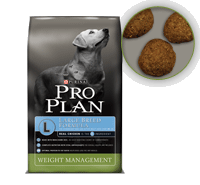|
|
|
Reviews
|
Views
|
Date of last review
|
|
1
|
30476
|
Thu January 10, 2008
|
|
|
Recommended By
|
Average Price
|
Average Rating
|
|
No recommendations
|
None indicated
|
None indicated
|
|
|
|

|
|
Description:
|
Feeding guideline:
A 50lb dog should be fed 2 1/3 - 4 1/4 cups
CALORIE CONTENT (CALCULATED):
Metabolizable Enerfgy (ME)
3462 kcal/kg
1572 kcal/lb
369 kkcal/cup
Digestable Energy
1707 kcal/lb
401 kcal/cup
INGREDIENTS:
Chicken, brewers rice, whole grain wheat, poultry by-product meal (natural source of glucosamine), oat meal, pearled barley, corn gluten meal, pea fiber, fish meal (natural source of glucosamine), animal fat preserved with mixed-tocopherols (form of Vitamin E), animal digest, egg product, fish oil, dicalcium phosphate, potassium citrate, salt, potassium chloride, choline chloride, Vitamin E supplement, L-Lysine monohydrochloride, zinc sulfate, L-ascorbyl-2-polyphosphate (source of Vitamin C), ferrous sulfate, manganese sulfate, niacin, Vitamin A supplement, calcium carbonate, copper sulfate, calcium pantothenate, garlic oil, pyridoxine hydrochloride, Vitamin B-12 supplement, thiamine mononitrate, riboflavin supplement, calcium iodate, Vitamin D-3 supplement, menadione sodium bisulfite complex (source of Vitamin K activity), folic acid, biotin, sodium selenite.
C-4481
GUARANTEED ANALYSIS:
Crude Protein (Min) 26.0%
Crude Fat (Min) 9.0%
Crude Fat (Max) 13.0%
Crude Fiber (Max) 5.5%
Moisture (Max) 12.0%
Linoleic Acid (Min) 1.3%
Calcium (Ca) (Min) 0.9%
Phosphorus (P) (Min) 0.7%
Selenium (Se) (Min) 0.30mg/kg
Vitamin A (Min) 15,000 IU/kg
Vitamin E (Min) 460 IU/kg
Ascorbic Acid* (Min) 70 mg/kg
Glucosamine* (Min) 500 ppm
Glutamine* (Min) 1.0%
Taurine* (Min) 0.05%
*Not recognized as an essential nutrient by the AAFCO Dog Food Nutrient Profiles.
|
|
|
|
Editors
Registered: October 2005
Posts: 3953
|
|
Review Date: Thu January 10, 2008
|
Would you recommend the product? No |
Price you paid?: Not Indicated
| Rating: 0
|
|
Pros:
|
First ingredient is a named meat product
|
|
Cons:
|
Inadequate meat content, byproducts and fat of unidentifiable origin, low quality grains and filler
|
|
The first ingredient is a named meat product. This is not a meal ingredient, but is inclusive of water content (about 80%). Once that is removed, as it must be to create a dehydrated product, the ingredient will weigh around 20% of its wet weight. Ingredients are listed in order of weight, and the dehydrated ingredient would probably be more accurately placed much further down the ingredient list. It is unlikely that this ingredient makes any significant contribution to the overall meat content of the food. The main meat ingredient in this food is in fact poultry by-product meal. It is impossible to ascertain the quality of by-products and these are usually products that are of such low quality as to be rejected for use in the human food chain, or else are those parts that have so little value that they cannot be used elsewhere in either the human or pet food industries. The AAFCO definition of poultry by-product meal is âa meal consisting of the ground, rendered, clean parts of the carcass of slaughtered poultry, such as necks, feet, undeveloped eggs and intestines, exclusive of feathers, except in such amounts as might occur unavoidable in good processing practice.â Unable to be identified even by species or source, it is a very low quality ingredient. This is the 4th ingredient, making it unlikely that there is any significant meat content in the food at all, but rather it is primarily a collection of grains.
Fish meal is a further meat ingredient in the food, but it is far too far down the ingredient list to make any significant contribution to the overall meat content of the food. We find no sign on the manufacturer's website of a guarantee that only ethoxyquin-free protein ingredients are used in this food (ethoxyquin is a chemical preservative, commonly added to fish ingredients, and that is banned or heavily regulated in human food due to the belief that it is carcinogenic).
The main grains, and main ingredients, in the food are brewers rice and wheat. Brewers rice is a low quality grain and byproduct. Wheat is believed by many to be the leading cause of food allergy problems in dog food; at least in this case it is a whole grain. Oatmeal and barley are decent quality grains, but corn is a difficult to digest grain of limited value in dog food. It is also commonly associated with allergy problems. Corn gluten meal it is that part of the commercial shelled corn that remains after the extraction of the larger portion of the starch, gluten, and term by the processes employed in the wet milling manufacture of corn starch or syrup. In plain English, the remains of corn after most of the nutritious bits have been removed. Pea fiber is filler.
Animal fat is an ingredient of unidentified origin for which it is impossible to determine species, source or quality. Unidentified ingredients are usually very low quality. AAFCO define this asobtained from the tissues of mammals and/or poultry in the commercial processes of rendering or extracting. It consists predominantly of glyceride esters of fatty acids and contains no additions of free fatty acids. If an antioxidant is used, the common name or names must be indicated, followed by the words "used as a preservative". We would prefer to see the use of whole eggs rather than egg product in the food.
We note the use of synthetic vitamin K, a substance linked to liver problems and that is progressively being removed from better quality products.
|
|
|
Powered by: ReviewPost PHP
Copyright 2006 All Enthusiast, Inc.
|
|